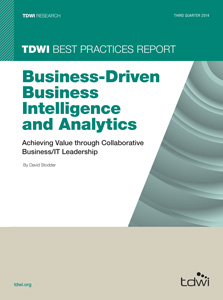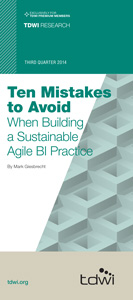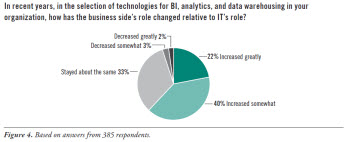 View online: tdwi.org/flashpoint
View online: tdwi.org/flashpoint





December 11, 2014
ANNOUNCEMENTS
NEW TDWI Analytics Maturity Model and Assessment Tool
Take the Assessment Now
NEW TDWI Checklist Report
Telling a Story with Data
NEW TDWI E-Book
Predictive Analytics: Revolutionizing Business Decision Making
CONTENTS

Data Governance in the Age of Agile BI

Achieving Faster Analytics with In-Chip Technology

BI and Analytics Technology Selection Process Roles

Mistake: Not Preparing for Post-Project Demand

See what's
current in TDWI Education, Events, Webinars,
and Marketplace

Data Governance in the Age of Agile BI
Dave Wells
BI Consultant, Mentor, and Teacher
Topics:
Agile BI
Can governance and agile coexist? The answer must be “yes” because we need both governance and agility, but getting there is challenging. It is commonly believed that agile and governance are in conflict—that the processes of governance are too burdensome and become barriers to agile development.
In reality, agile and governance can work together quite effectively, but only with a change in mindset. We need to think differently about agile teams and how we govern—shifting the work of governance from outside the agile process to part of the agile process, and focusing governance on value produced instead of processes followed.
Change in mindset begins with attention to people. We don’t really govern data; we govern people’s behavior when working with data. Understanding that data governance is really about people is a good beginning.
Next, recognize that agile is more than fast, iterative development. It includes people who are the real subjects of governance. An agile organization involves planning and oversight as well as development. Agile teams that are aligned with these activities—a planning and oversight team and one or more development teams—form the foundation of agile data governance.
The planning and oversight team is made up of sponsors, stakeholders, and business subject matter experts. This team has responsibility for vision, goals, funding, and the project charter. Their work is focused on strategy and release activities, and they participate in defining the iterative activities that bring continuity to multiple development projects.
The development team is a collaboration of end users and developers working under the guidance of a team lead. This team is responsible for discovering requirements, designing solutions, and building systems, and members’ work is focused on continuous development, daily planning, and iteration as a bridge to planning and oversight activities.
With this team structure, agile governance begins with the planning and oversight team. These stakeholders—functional, legal, regulatory, risk, financial, and operational—are positioned to understand the needs of governance and express those needs as constraints, expectations, and requirements for the development team. The development team is responsible for including governance needs in the development process and communicating with stakeholders to fully understand governance goals and constraints.
Using this team structure, it becomes practical to embed data governance into agile processes. Data governance stakeholders become members of agile teams, and:
- Data owners become members of an agile planning and oversight team
- Data specialists and custodians become members of agile development teams.
- Data stewards connect the efforts of the two teams, linking the governance expectations and constraints of long-term planning with the activities of continuous development
Data stewardship is particularly important in making agile data governance work well. Data stewards are the core of agile data governance, filling three essential roles:
- As members of a planning and oversight team, data stewards focus on data strategy and a road map, including data governance goals
- As members of development teams, data stewards embed a governance perspective into project work
- As a communications channel between planning and development teams, data stewards ensure that developers are aware of governance constraints, expectations, and requirements; they also make sure planners know the project impacts of governance
Adapting agile teams to governance concerns is only one part of making agile and governance work well together. Governing with agility also demands a change of governance practices with the objective of enabling rather than inhibiting agile projects. Governance often functions as an external entity exerting control over projects and their deliverables. Agile governance is part of development projects, not something external. Governance activities shift from control to participation to help projects succeed while simultaneously meeting governance goals.
Enterprises that are successful with agile data governance typically adopt these governance practices:
- Focus on value produced, not methodology and processes. This includes value to the project and enterprise value produced by meeting governance goals.
- Govern proactively by introducing constraints as requirements at the beginning of a project instead of seeking remedial action at the end. Attempting to introduce constraints in the midst of an active agile project is more disruptive than end-point remediation.
- Strive for policy adoption over policy enforcement. Make it easy to comply with policies—communicate the reasons for and value created by them. Motivate people to adopt and little enforcement will be necessary.
- Write brief, concise, clear, and understandable policies. Use simple, unambiguous language to avoid misinterpretation.
- Include data stewards on project teams. They bring valuable knowledge and are generally great collaborators.
- Think “governance as a service" instead of “authority and control.”
- Practice agile data definition. Get definitions from user stories and write brief definitions that describe what it is and what it isn’t. Provide an example or two.
- Be quick and responsive. Govern at the speed of agile.
- Don’t let unresolved issues become project delays. Think issue remediation first, with just enough to let the project continue, then pursue issue resolution without disrupting projects.
- Evolve data models. Don’t expect them to be right the first time. Jump start with data model patterns and adapt to change by developing data model and database refactoring as core skills.
Dave Wells is actively involved in information management, business management, and the intersection of the two. As a consultant, he provides strategic guidance for business intelligence, performance management, and business analytics programs. He is the founder and director of community development for the Business Analytics Collaborative.

Achieving Faster Analytics with In-Chip Technology
Elad Israeli
In-memory technology accelerates the performance of relational database management systems and online analytical processing, but cost and scalability are formidable challenges to its adoption. This article looks at how a recent innovation—in-chip technology—takes the best features and characteristics of in-memory technology and overcomes the drawbacks by efficiently using hard disks, RAM, and CPU to enable large storage capacity and strong performance.
Learn more: Read this article by downloading the Business Intelligence Journal, Vol. 19, No. 3



Highlight of key findings from TDWI's wide variety of research
BI and Analytics Technology Selection Process Roles
Business-side role is increasing in technology selection. Overall, our research finds that while IT remains in the leadership position, as noted earlier, nonetheless the business-side role in technology selection for BI, analytics, and data warehousing is increasing. Looking at Figure 4, we can see that the largest percentage of research participants (40%) indicated that the business side’s selection role had increased somewhat and an additional 22% said it had increased greatly. We find that the percentage of research participants indicating larger business-side roles in technology selection is higher among those from organizations where most users are implementing BI and analytics tools. Among research participants who indicated that more than half of their organizations’ users are working with the tools, 41% said the business side’s role had increased at least somewhat and 32% said it had increased greatly. Democratization of BI and analytics appears to increase the business side’s role in technology selection.
Read the full report: Download Business-Driven BI and Analytics (Q3 2014)



FlashPoint Rx prescribes a "Mistake to Avoid" for business intelligence and data warehousing professionals.
Mistake: Not Preparing for Post-Project Demand
Mark Giesbrecht
It’s rare for BI solutions to stay static and not require periodic enhancements if they are supporting dynamic business processes. New KPIs, new dashboard drill paths, adjustments to business rules, handling periodic data quality issues, and streamlining job flows to improve data availability are just a few of the many improvements business users are likely to request over time to keep the solution relevant.
A mature BI practice will ensure an adequately staffed and transparent process is in place to quickly triage enhancement requests into a backlog that can be prioritized and acted on. Failure to respond in a timely manner to these requests may leave frustrated business users with the perception that IT cannot act quickly enough, or worse, is indifferent to their needs. This, in turn, could force business users to create their own shadow warehouse, driving data proliferation with competing versions of the truth and increasing TCO.
Given this risk, it is also important that both the backlog of work beyond the project and the enhancement process be reviewed with the sponsors before the project closes. If the urgency of the outstanding work is greater than the expected rate of enhancements, then the sponsors should consider extending the project until the backlog settles to a reasonable level.
Read the full issue: Download Ten Mistakes to Avoid When Building a Sustainable Agile BI Practice (Q3 2014)




